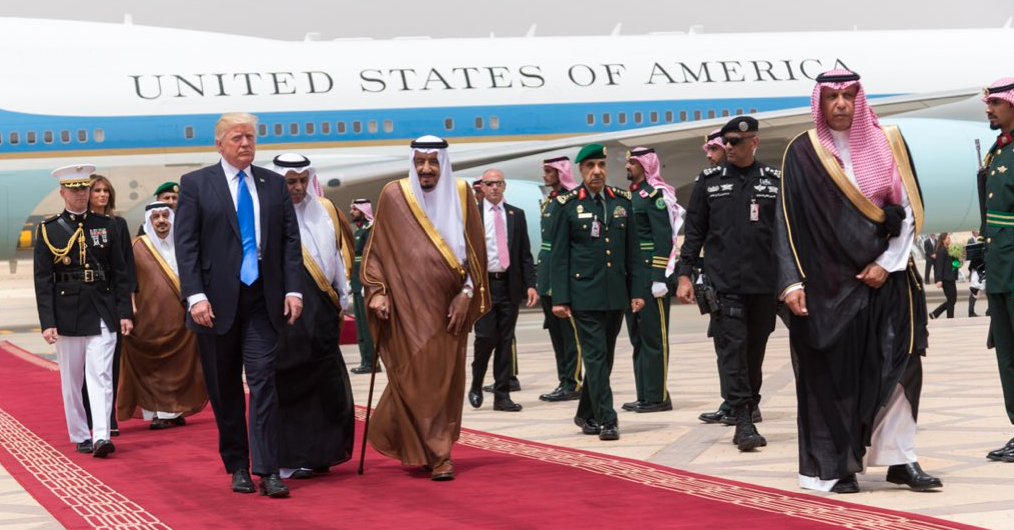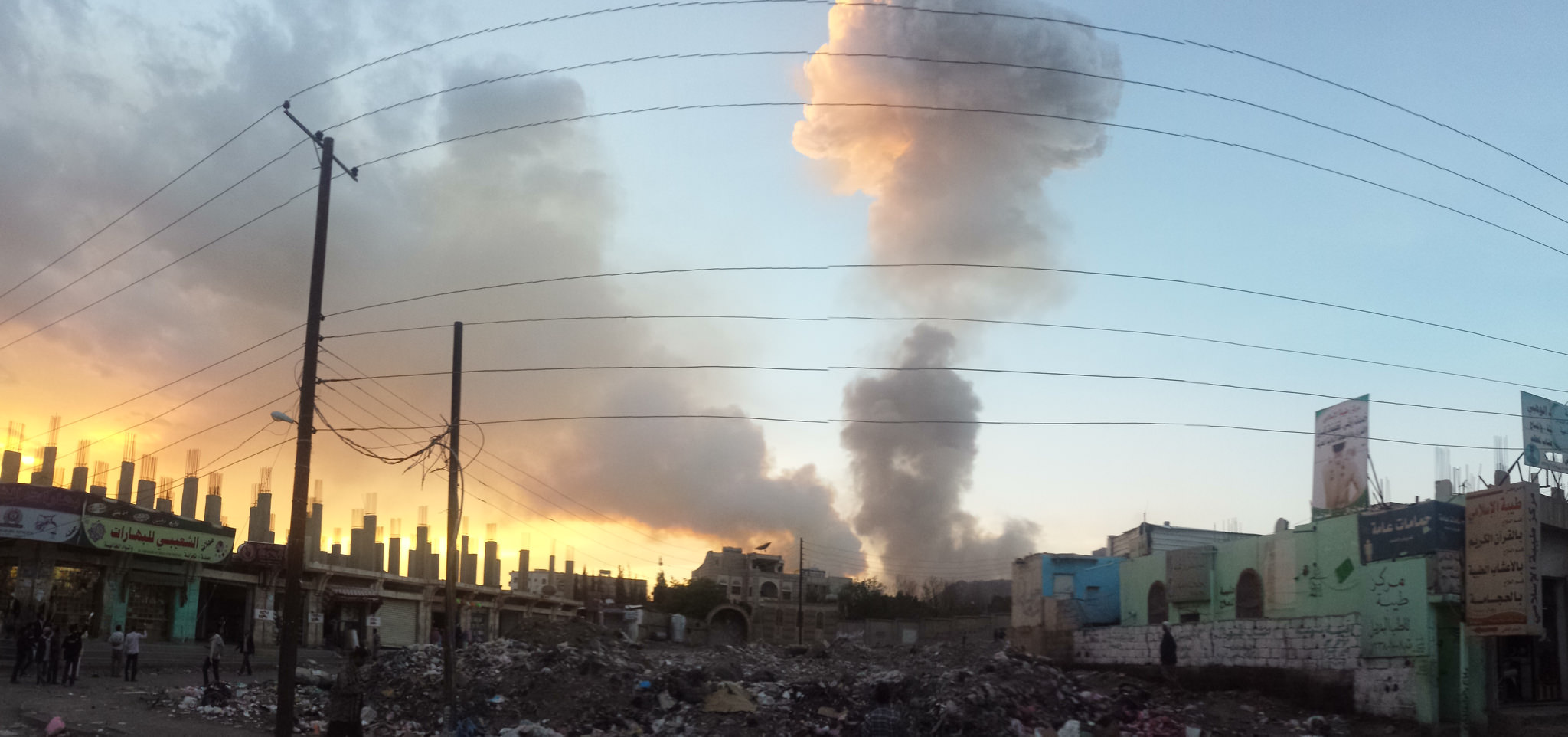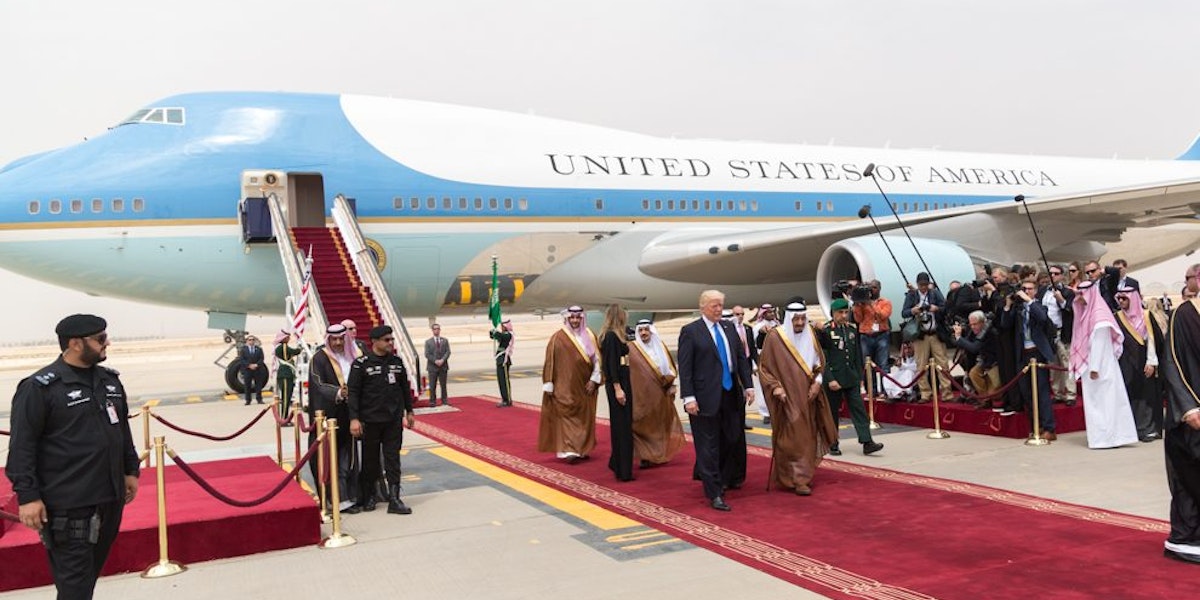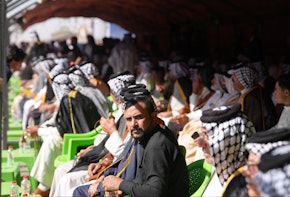Driven by fear of an expanding Iran, Saudi Arabia has begun pursuing an aggressive, hardline foreign policy that has the potential to harm regional stability, and with it, U.S. regional interests. The United States and Saudi Arabia share a long history, a partnership shaped by oil and arms that has been strengthened by a shared enemy of Iran. But the alliance was tested under the Obama administration, which attempted to disengage from previous overextension in the region and made overtures to Iran. Today, led by a new generation of hawkish leaders who are taking advantage of what they see as the U.S. abandonment of its position as regional hegemon, the Saudis are engaged in a war in Yemen to roll back Iranian-supported rebels, and have imposed a diplomatic and economic blockade on Qatar—in part because of its ties to Iran.
The United States has two response choices in the face of the forceful new Saudi position—it can support the Saudis along this trajectory, or leave them to pursue it on their own, whilst doing what it can to manage the regional consequences to protect its interests, which are not identical to Saudi Arabia’s. In making its decision, the United States needs to take full stock of this shift in Saudi posture, and carefully recalibrate its approach to the region’s newest revisionist power to avoid encouraging aggressive Saudi behavior that has the potential to grossly destabilize the region.
America’s Strategy in the Middle East, from Carter Doctrine to the Obama Administration
From the 1940s until the recent “shale revolution,” which allowed the United States to significantly increase its own oil production,1 American posture towards the Middle East was defined in large part by oil and access to it. For decades, the United States relied heavily on Middle Eastern nations for oil, and following Britain’s withdrawal from the area in 1971 they relied on the “twin pillars” of Iran and Saudi Arabia to maintain regional security. After the Islamic Revolution of 1979 transformed Iran from a strong ally in the region into a threat, the United States shifted gears and turned to the Arab Gulf states,2 specifically Saudi Arabia, for oil and regional partnership. U.S. oil imports3 from Saudi Arabia peaked at 1.7 million barrels a day in 1991, about one-quarter of all American oil imports.
The Iranian Revolution did more than just cause a rearrangement of allies. It galvanized an understanding on the part of the United States that regional stability and security were essential4 to protecting its vital oil interests. The Gulf therefore required protection—the crux of the Carter Doctrine5 (1980), which stipulated that the United States would use military force if necessary to defend national interests in the Gulf region.6 The doctrine has implicitly been invoked time and time again by multiple U.S. administrations. After the Iranian Revolution, the United States established a military presence in the Gulf for the first time. During the Iran-Iraq war that broke out shortly after, the United States expanded its commitment to the Gulf region, initially providing support for the Iraqis and then allying with Saudi Arabia against then-Iraqi President Saddam Hussein after he invaded Kuwait in 1991. During the first Gulf War, military cooperation7 between the United States and its number-one ally in the region was at an all-time high. Then in 2003, the United States invaded Iraq and toppled the Hussein regime, starting a long and costly war that would bring U.S. involvement in the Middle East under wide scrutiny at home and around the globe.
Criticism of the Iraq war—its origins, the troop surge—was an integral part of Barack Obama’s successful presidential campaign platform in 2007–2008. Once in office, the Obama administration made it a goal to pull troops out of Iraq and focus on the war in Afghanistan.8 As a foreign policy realist, President Obama was not in support of intervention for non-security based reasons—liberalist engagement was too costly and distracting. The failure of the Libya intervention9 on his watch cemented this belief. Though the intervention successfully removed Muammar Qaddafi, there was no legitimate replacement to govern a society that was already falling apart at the seams. The sentiment in the Obama administration was that the failure in Libya was rooted in the behavior of “free-riders”—Middle Eastern and European allies who were not pulling their weight.10 Following the Libya intervention, U.S. regional allies feared that the United States was moving from active involvement to disengagement. Regional leaders, particularly the Saudis, viewed this shift as abandonment.11

America’s Growing Disinterest: The Saudi Perspective
The Saudis seem to view America’s role in the region in terms of a zero-sum game: the United States either bolsters Saudi influence, or Iranian influence, but not both. Saudi leaders initially saw Obama as a beacon of hope12 for U.S.-Middle Eastern relations following the loss of credibility America had suffered in the region during George W. Bush’s presidency. At the same time, they never trusted Obama.13 Rather, the Saudis perceived the Obama administration’s movement away from the region and its efforts to de-escalate tensions with Iran as an abdication of America’s decades-long role in containing Iranian influence in the region. Iran, the Saudis feared, had been granted access to the region. To the Saudis, the United States was inadvertently handing over the reins to the Iranians by improving even the most superficial of relationships with them.
The Saudis seem to view America’s role in the region in terms of a zero-sum game: the United States either bolsters Saudi influence, or Iranian influence, but not both.
The Obama administration, however, didn’t have the same black-and-white understanding of the Saudi-Iran relationship. In a very hostile region, it saw the ideal situation stemming from an achievement of ‘cold peace’14 between the two age-old rivals. The United States deemed reducing tensions with Iran necessary to create such an environment. As a result, the appearance of an American-Iranian amity emerged, and caused a profound sense of distrust and anxiety in the Saudis, which led them to interpret the following U.S. decisions as emboldening Iran.
Egypt: “The U.S. Abandoned Mubarak”
When mass protests broke out against then-Egyptian President Hosni Mubarak in 2011, divided as the Obama administration was on how to deal with the situation, Obama eventually decided on calling for Mubarak to step down.15 The decision came as a shock to several leaders16 in the region, especially the Saudis and Emiratis who saw Obama abandoning a long-time Washington ally. The Saudis were worried about the precedent17 that Mubarak’s stepping down would create in the Arab world, and how this precedent could threaten the existence of its monarchy. They feared the space left by Mubarak could be filled by Islamists,18 paving way for the Sunni equivalent of the Iranian Revolution. The Saudi-Egypt-U.S. nexus19 in the containment of Iranian ambitions in the region was also vulnerable to collapsing without Mubarak and his policies. While the United States was embracing what they saw as the opportunity for reform in the region, the Saudis saw this strategy as compromising the efforts to contain Iran and promote moderate policy in the region.
Syria: “The U.S. Was Too Soft on Assad”
Obama’s inaction on his “Assad must go” policy in Syria served as another demonstration to the Saudis that American disengagement was having the effect of emboldening Iranian influence in the region. The Saudis, as well as several of Obama’s national security advisors, understood as credible Obama’s threat20 of military action against the Assad regime for the use of chemical weapons. So when Obama called off U.S. airstrikes in Syria in 2013, and instead pursued a proposal by the Russians21 to have them remove chemical weapons, the Arab world saw him crossing his brightly drawn “red line.” Obama’s credibility22 took a beating in the eyes of much of the leadership in the Middle East, including Jordan, the United Arab Emirates (UAE) and Saudi Arabia. By failing on its commitment to take military action and making a deal with the Russians instead, the Saudis saw the United States as not just taking another step away from efforts to contain Iran, but as giving Iran viable hosts in which to survive in the region—Russia and Assad. The United States did pursue a recently-terminated covert program23 to train and equip anti-Assad rebel groups that fall under the Free Syrian Army (FSA) umbrella. But it is unlikely that the Saudis viewed this program as sufficient as they have also been supporting FSA groups24 with money and weapons since 2012. Arguably, the Saudis were looking to the Americans to do more than what the Saudis themselves were capable of doing, and not just duplicate their efforts.25
The Iran Nuclear Deal: “The U.S. Chose Iran”
No decision point conveyed as clearly to the Saudis that the United States had backed away26 from its decades-long responsibility of containing Iranian influence quite like the 2015 Joint Comprehensive Plan of Action (JCPOA), known as the Iran deal. By lifting the international economic sanctions on Iran, the deal effectively normalized Iran’s status27 in the international arena—it was no longer a pariah state. Although the Saudis were not as vocally critical of the deal as the Israelis were, they were deeply concerned28 with the potential that the deal had to give Iran a freer hand in the region. The Obama administration refuted the accusation that it was pivoting towards Iran by arguing that the deal it helped broker made the “dangerous [Iran], substantially less dangerous.”29 However, Saudi leaders didn’t seem to buy the idea. The existential threat to the Saudi state by Iran’s development of a nuclear weapon still remained—Iran’s capability has not been destroyed, only delayed.30 The Saudis also saw the deal as a missed opportunity to demand that Iran correct its behaviour outside of the nuclear deal.31

U.S. Options as Saudi Tries to Step Up as Regional Hegemon
With America’s increasing disengagement from the Middle East, the Saudis have seen that the role of regional hegemon has been left wide open—a spot that the Saudis fear could be easily be filled by an emboldened Iran. Saudi Arabia is opportunistically trying to fill this gap to both squeeze out any Iranian influence in the region and also to set the terms of regional engagement. Driven by a profound sense of fear and anxiety about Iran on the loose, Saudi has abandoned its typical, quiet, diplomatic foreign policy approach,32 opting instead for an assertive and aggressive foreign policy.
With America’s increasing disengagement from the Middle East, the Saudis have seen that the role of regional hegemon has been left wide open—a spot that the Saudis fear could be easily be filled by an emboldened Iran.
Propping Up Sisi
Saudi Arabia put its first assertive foreign policy foot forward when outwardly supporting the overthrow of President Mohamed Morsi33 by the Egyptian military in 2013, demonstrating the anxiety Saudis felt about having the Muslim Brotherhood in the driver’s seat in Cairo. Already antagonistic towards the Muslim Brotherhood34 for its alternative approach to religious legitimacy and how it could threaten the survival of the Saudi monarchy, Saudi hostility was compounded by the prospect of the Brotherhood’s openness towards rapprochement with Iran.35 Morsi, unlike Mubarak, could thus never be the strong pillar in the Egypt-U.S.-Saudi dynamic for containing Iranian influence in the region. The Saudis poured in billions of dollars to support the new regime, eventually led by Abdul Fattah al-Sisi. They even offered to pay whatever foreign aid Egypt was denied36 by the United States and the European Union as a reprimand for violent repression of pro-Morsi protesters. By providing both political and financial support for Egypt’s new regime, Saudi Arabia demonstrated its ability to fulfil the duties of a regional leader.
The once strong Egypt-Saudi relationship has come under pressure due to disagreements on regional issues, which may pose an opportunity for the United States to engage as a peacemaker. On Assad, the Saudis are pushing to have him removed from power,37 while the Egyptians favor his regime over an Islamist replacement. Egypt has also avoided major involvement38 in the Saudi-led war in Yemen, indicating to the Saudis that it has different priorities, and Iranian expansionism isn’t one of them. The failure of the Red Sea Islands transfer from Egypt back to Saudi has resulted in a Saudi freeze39 on aid and oil shipments to Egypt. However, isolating Egypt in this way is not conducive to the north-African country’s stability, which is of large importance to both the Saudis and the Americans. This fractured Egypt-Saudi relationship and shared U.S.-Saudi interests in Egypt’s stability may provide the Trump administration with an opportunity to redefine its terms of engagement with the Middle East. The Qatar crisis has also seen a recent easing of tensions between Saudi Arabia and Egypt. By opting for the role of a diplomatic mediator, the United States would demonstrate its commitment to securing its interests in the region, without overextending. This may also allay some of the Saudi fears that America has completely stepped away from the region.
Military Aggression in Yemen
Saudi intervention in Yemen in 2015 represented a much more significant departure from diplomacy-oriented foreign policy towards an aggressive policy position. Demonstrating their military leadership like never before, the Saudis intervened40 to protect President Abed Rabu Mansour al Hadi from the Houthis—a Yemeni Zaydi Shia-led rebel group—and other forces loyal to former President Saleh, who had overrun Sana’a. The Saudis formed a military coalition and launched an offensive to roll back the insurgency. Saudi leadership has always viewed the Houthis as a minority group that has the support of Iran41 for security. This belief was confirmed42 two years into the intervention, which has now turned into a full-blown war. Despite coming under heavy criticism from the international community for continuing a campaign that has devastated what was already the poorest Arab state,43 the Saudis insist that the war is one of necessity, not one of choice.44 They argue that stopping Iranian influence is an imperative of Saudi national security and foreign policy.
The aggressive Saudi agenda in Yemen appears to have a tripartite purpose—firstly, it actively attempts to push out the Iranian influence; secondly, it sends a message to Iran that the change in U.S. posture toward Iran in no way weakens the Saudis; and thirdly, it communicates to the United States that the Kingdom doesn’t need the Americans and can lead a war on its own. The United States, however, should not respond to these messages by either backing away militarily or further increasing its involvement in the conflict, as both the Obama and Trump Administrations have done. In December 2016, the Obama administration placed restrictions on sales of certain precision-guided heavy weapons45 to Saudi Arabia after U.S.-provided munitions that were used by the Saudis to bomb a funeral in Yemen killed 140 people. President Trump has since reversed these restrictions, signing a new weapons deal with the Saudis.46
Instead, the United States’s approach to Saudi Arabia’s war in Yemen needs to focus on avoiding deepening American involvement in the war, whilst at the same time preventing Saudi’s adventurism in Yemen from harming U.S. interests, primarily regional stability. To do this, the best choice may be for the U.S. government to invest more in humanitarian efforts, signalling to the Saudis a new regional engagement strategy that both protects American interests and uphold its values without embroiling the United States in the Middle East’s internal affairs.
Blockading Qatar: Nothing Slip Through the Cracks
Saudi anxiety about an emboldened Iran has most recently manifested itself in the cutting of diplomatic and economic ties with Qatar.47 The United States has thus far exercised restraint48 in the diplomatic crisis (notwithstanding President Trump’s remarks49), though the Saudis may have hoped for a more decisive stance in their camp. The Saudis have led an aggressive campaign towards their neighbor, with the UAE, Bahrain and Egypt by their side. Tension between the members of the Gulf Cooperation Council (GCC) has been building since the Arab Spring. The Qataris backed Morsi’s government and later provided refuge for Muslim Brotherhood members following the military’s 2013 removal of Morsi, while Saudi, the UAE and Egypt classified the group as a terrorist organization. This culminated in a diplomatic rift, with Saudi, the UAE, and Bahrain recalling their ambassadors50 from Qatar in 2014. The issue was resolved only superficially—the underlying grievances and tensions went unaddressed.
Regarding this year’s Gulf crisis, the Saudis, Emiratis, and Egyptians argue that the actions they have taken against Qatar are in the interest of both regional stability and national security. They view Qatar’s ties with Iran, and its alleged support for terrorist groups like ISIS and al Qaeda, as well as for Iran-backed rebel groups in Yemen and Bahrain, as dangerous to the region.51 However, not all of the allegations have been substantiated by evidence. The Saudi block’s list of demands that followed three weeks after the crisis have triggered a response from the international community52 calling for more measured, reasonable, and actionable requests. Albeit not immediately, the Saudi block had reduced its thirteen demands to six, less-specific principles,53 demonstrating some openness to negotiation.
First and foremost, the crisis is a manifestation of the complexities and differences that underscore the strained relationship between Qatar and its neighbours. However, this crisis has also been compounded by President Trump’s efforts to achieve rapprochement with the Saudis. It has been widely argued that President Trump played a role in emboldening the Gulf countries to make moves against Qatar during a speech he delivered earlier this year in Riyadh, calling on the GCC states to combat threats from extremists and Iran.54 However, it seems more likely that Trump’s strong anti-Iran rhetoric triggered, more so than emboldened, the Gulf states to act and see how much they could make of this new style of U.S. engagement. The Saudis and Emiratis, especially, demonstrated their hardline stance on matters concerning Iran well before the Trump presidency.
Despite President Trump’s meddling, the United States should avoid picking sides in the divided Sunni Arab world for the sake of stability. Trump has openly demonstrated his support55 for the Saudi-block’s move against Qatar, however, a fragmented Arab-Gulf front is much less useful in keeping the Iranian influence out of the region, and in countering terrorism. Unity among these states provides the force that both the Americans and the Arabs need to counter both Iran and terrorism. At the same time, the United States should not step back from the crisis to let it develop organically and resolve itself. The United States needs to tread carefully, and should strive to maintain the position that Secretary of State Rex Tillerson has already taken: that of a mediator that pursues diplomacy to end the crisis in order to protect U.S. interests, including Al Udeid56 air base in Qatar. In order to encourage the Saudi-block to further de-escalate tensions and resolve the crisis, the United States, too, needs to present a united front and adopt a uniform message of compromise on this issue. This will require reining in the president.
Flexing Without Muscle: Lack of Saudi Capacity and Judgment
The Saudis have indeed demonstrated that they can carve out a hardline regional foreign policy and can also implement it. However, they have not yet shown their understanding of the two imperatives of fulfilling an agenda item, and doing it well. The war in Yemen has raged on for two years, however it has not managed to achieve much of its goals—primarily rolling back the Houthis from Sana’a and restoring the Hadi government. Instead, the war has contributed significantly to Yemen’s humanitarian crisis and its descent further into poverty. As for the Gulf crisis, there have been some late de-escalation attempts, but there is still no resolution in sight, despite mediation efforts from the West and regional actors.
An aggressive foreign policy that lacks foresight can only take the Saudis so far.
The pattern of stalemates in Saudi’s regional interventions point to the short-sightedness of Saudi’s aggressive policies, and its gross inexperience in interventionist practice. Instead of asserting Saudi prowess in the region, the war in Yemen has called into question Saudi Arabia’s military leadership—the kingdom launched unprepared and error-prone troops57 into a billion-dollar war for which there is no exit strategy. On the Qatar issue, the Saudis assumed they could strong-arm their small neighbor and coerce it into submission, overlooking the possibility that the plan could fail. An aggressive foreign policy that lacks foresight can only take the Saudis so far. The role of regional hegemon requires a much more profound understanding of regional dynamics in order to effectively implement change.

Rise of the Saudi Hawks
Saudi Arabia’s shift toward an aggressive foreign policy is also a result of the rise of the “Saudi hawks”58: former Crown Prince Mohammed bin Nayef, current Crown Prince Mohammed bin Salman, and Foreign Minister Adel al-Jubeir. All three strongly endorsed59 the war in Yemen against the Houthis and advocated taking a hardline stance60 against an unpredictable Iran. Jubeir has remarked61 that Saudi can live with a peaceful Iran that complies with international law, but that “is not the Iran [they currently] see.” He has also publicly labelled62 Iran as the main sponsor of global terror.
Mohammed Bin Nayef, before he was stripped of his titles as Interior Minister and Crown Prince, was also afforded the status of Saudi hawk—as well as that of the favorite of the United States.63 However, the veracity of that status is questionable. The recent shuffle64 in the line of succession in the House of Saud saw the earmarked future King of Saudi Arabia moved aside for his thirty-one-year-old cousin, Mohammed Bin Salman, King Salman’s favourite son. Writ large, the move appears to be an effort to truly “consolidate the hold of Saudi hawks over foreign policy.”65 The reasons surrounding Mohammed Bin Nayef’s dismissal have been kept under tight seal, which leaves room for the inference that a less than hawkish stance on Saudi Arabia’s foreign policy—especially on the issue of the Gulf crisis—may have been Mohammed Bin Nayef’s ultimate downfall.
Mohammed Bin Salman showcased his hawkish tendencies on a number of occasions during his short two-year run as the kingdom’s defense minister. He oversaw the war in Yemen66 and was a central figure67 in the plan to isolate Qatar. Both projects have been conducted in line with the overarching hardline Saudi foreign policy goal of containing Iran.68 Although the Saudis have been pursuing an anti-Iran foreign policy since well before the first succession line change-up upon King Abdullah’s death in 2015, the ascent of Mohammed Bin Salman has intensified the process. He shut down suggestions for dialogue and negotiation, and dove straight into confrontation and escalation of hostilities with Yemen, Iran, and Qatar.
Saudi hotheadedness is not what the United States is used to dealing with. Mohammed Bin Nayef was worlds apart from his cousin in dealing with the Kingdom’s foreign policy and counterterrorism efforts. While Mohammed Bin Nayef took a more measured approach, for which he won American respect and trust, Mohammed Bin Salman is more ruthless in his policy choices. For the United States, rethinking its relationship with Saudi Arabia will evidently have to include a change in how it approaches and engages with the Saudi leadership. With a new generation of Saudi leaders who are more partial to aggression, the United States may need to redefine the resources and support it can leverage to keep the young Saudis from running amuck.
Although the United States’s public posture towards the region may have shifted during the Obama administration, security partnerships between Riyadh and Washington are still by and large the same, if not stronger. The Saudis still import about half of their arms from the United States, and both countries coordinate closely on counterterrorism efforts and intelligence sharing.69 This demonstrates that the complex Washington-Riyadh marriage is still intact, but fractured. However, Saudi dependence on U.S. arms agreements may also begin to diminish if Mohammed Bin Salman manages to achieve his plan for an overhaul of the Saudi economy as per “Saudi Vision 2030,” which includes plans for military industry development.70 Mohammed Bin Salman seeks to weaken the Kingdom’s dependence on military imports and instead start producing arms domestically, increasing domestic military spending from 2 percent to 50 percent by 2030. If successful, such military advancements could turn Saudi Arabia into a regional arms supplier, furthering its efforts to assume the role of a key regional leader. This would complement the plan to boost their regional standing by way of expansive trade and integrations policies. However, these plans are still in the very early development phase, and so for now, the kingdom is using its aggressive foreign policy to earn its status as a regional leader.
The Way Forward for the United States
Saudi Arabia’s hardline foreign policy has gained significant traction in the past four years since it was created by hawkish leaders in response to the Obama administration’s disengagement from Iranian containment efforts. The Saudis seem firmly committed to their aggressive agenda, amping up their role in the region by starting a war, and imposing a blockade on a country a fraction of its size. While it is not in America’s favor to return to its days of heavy intervention, neither would it be beneficial to step away. The region may not be as important to the United States as it once was, but there are American interests that are still very worthwhile protecting. These very interests are under threat as both regional (Saudi Arabia and Iran) and global (Russia71 and China72) powers compete to fill the role from which the United States appears to be retiring—that of the region’s dominant world power.
The Trump administration needs to take stock of the changing postures in the region and understand that it is dealing with a bolder, more hawkish Saudi Arabia than were its predecessors. This requires a re-evaluation of American engagement tactics across the board, all of which should be governed by cautious and measured strategies. The United States should consider taking up the role of mediator between Saudi Arabia and Egypt, and encourage a more unified stance on the current Gulf crisis. America needs to embrace the notion of keeping a respectful distance—as an effective mediator would—to secure its interests whilst avoiding getting pulled deeper into the whirlwind of Middle Eastern conflicts, which it could potentially exacerbate. The most immediate step this Administration needs to take is figuring out how to walk this tightrope.
Notes
- “Total Petroleum and Other Liquid Production 2017,” U.S. Energy Administration Information, 2017, https://www.eia.gov/beta/international/rankings/#?prodact=53-1&cy=2017&pid=53&aid=1&tl_id=1-A&tl_type=a.
- “U.S.-Saudi Relations,” Council on Foreign Relations, May 12, 2017, https://www.cfr.org/backgrounder/us-saudi-relations.
- “US Imports from Saudi Arabia of Crude Oil,” U.S. Energy Information Administration, 2017, https://www.eia.gov/dnav/pet/hist/LeafHandler.ashx?n=PET&s=MCRIMUSSA2&f=A.
- Kenneth M. Pollock, “U.S. Policy Towards a Turbulent Middle East,” The Brookings Institution, March 24, 2015, https://www.brookings.edu/testimonies/u-s-policy-toward-a-turbulent-middle-east/.
- Jimmy Carter, “The State of the Union Address Delivered Before a Joint Session of the Congress,” The American Presidency Project, January 23, 1980, http://www.presidency.ucsb.edu/ws/?pid=33079.
- Kenneth M. Pollock, “U.S. Policy Towards a Turbulent Middle East”, The Brookings Institution, March 24, 2015, https://www.brookings.edu/testimonies/u-s-policy-toward-a-turbulent-middle-east/.
- “U.S.-Saudi Relations,” Council on Foreign Relations, May 12, 2017, https://www.cfr.org/backgrounder/us-saudi-relations.
- Bob Woodward, Obama’s Wars. New York, NY: Simon and Schuster, 2011.
- Jeffrey Goldberg, “The Obama Doctrine,” The Atlantic, April 2016, https://www.theatlantic.com/magazine/archive/2016/04/the-obama-doctrine/471525/.
- Ibid.
- Kenneth M. Pollack, “Fear and Loathing in Saudi Arabia,” Foreign Policy, January 7, 2016, http://foreignpolicy.com/2016/01/07/fear-and-loathing-in-saudi-arabia/.
- “Counterterrorism Adviser Brennan’s Meeting with Saudi King Abdullah,” WikiLeaks, March 22, 2009, https://wikileaks.org/plusd/cables/09RIYADH447_a.html.
- Jeffrey Goldberg, “The Obama Doctrine,” The Atlantic, April 2016, https://www.theatlantic.com/magazine/archive/2016/04/the-obama-doctrine/471525/.
- Ibid.
- Geoff Dyer and Heba Saleh, “Clinton and Obama: An American rift over an Egyptian Despot,” Financial Times, October 2, 2016, https://www.ft.com/content/38aead1a-9614-11e6-a80e-bcd69f323a8b?mhq5j=e1.
- Goldberg.
- Rene Rieger, “In Search of Stability: Saudi Arabia an the Arab Spring,” Gulf Research Center, 2014, https://www.files.ethz.ch/isn/182104/GRM_Rieger_final__09-07-14_3405.pdf.
- Dyer and Saleh.
- Rene Rieger, “In Search of Stability: Saudi Arabia an the Arab Spring,” Gulf Research Center, 2014, https://www.files.ethz.ch/isn/182104/GRM_Rieger_final__09-07-14_3405.pdf.
- Goldberg.
- Michael R. Gordon, “U.S. and Russia Reach Deal to Destroy Syria’s Chemical Arms,” New York Times, September 14, 2013, http://www.nytimes.com/2013/09/15/world/middleeast/syria-talks.html.
- Goldberg.
- Sam Heller, “America Had Already Lost Its Covert War in Syria—Now It’s Official,” The Century Foundation, July 21, 2017, https://tcf.org/content/commentary/america-already-lost-covert-war-syria-now-official/.
- Jonathan Schanzer, “Saudi Arabia Is Arming the Syrian Opposition,” Foreign Policy, February 27, 2012, http://foreignpolicy.com/2012/02/27/saudi-arabia-is-arming-the-syrian-opposition/.
- Sam Heller, “America Had Already Lost Its Covert War in Syria—Now It’s Official.”
- F. Gregory Gause, “Why the Iran Deal Scares Saudi Arabia,” New Yorker, November 26, 2013, http://www.newyorker.com/news/news-desk/why-the-iran-deal-scares-saudi-arabia.
- James Conca, “Iran Measures Up to the Nuclear Deal,” Forbes, January 14, 2016, https://www.forbes.com/sites/jamesconca/2016/01/14/iran-measures-up-to-the-nuclear-deal/#36a0de891f1b.
- Christopher M. Blanchard, “Saudi Arabia: Background and U.S. Relations,” Congressional Research Service, June 13, 2017, https://fas.org/sgp/crs/mideast/RL33533.pdf.
- Goldberg.
- “Why Saudi Arabia and Israel oppose Iran nuclear deal,” Al Jazeera, April 14, 2015, http://www.aljazeera.com/news/2015/04/saudi-arabia-israel-oppose-iran-nuclear-deal-150401061906177.html.
- “The Iran Nuclear Deal: What You Need To Know About the JCPOA,” The Obama White House Archives, July 14, 2015, https://obamawhitehouse.archives.gov/sites/default/files/docs/jcpoa_what_you_need_to_know.pdf.
- René Rieger, Saudi Arabian Foreign Relations: Diplomacy and Mediation in Conflict Resolution. Vol. 83. Abingdon, Oxon: Taylor & Francis, 2016.
- Rene Rieger, “In Search of Stability: Saudi Arabia an the Arab Spring,” Gulf Research Center, 2014, https://www.files.ethz.ch/isn/182104/GRM_Rieger_final__09-07-14_3405.pdf.
- Toby Matthiesen, “The Domestic Sources of Saudi Foreign Policy: Islamists and the State in the Wake of the Arab Uprisings,” The Brookings Institution, August 2015, https://www.brookings.edu/wp-content/uploads/2016/07/Saudi-Arabia_Matthiesen-FINALE.pdf.
- Rene Rieger, “In Search of Stability: Saudi Arabia an the Arab Spring.”
- Ibid.
- Bernard Haykel, “Saudi Arabia and Egypt: An Uneasy Relationship”, Stanford University Hoover Institution, The Caravan, March 14, 2017, http://www.hoover.org/research/saudi-arabia-and-egypt-uneasy-relationship.
- Ibid.
- Ibid.
- Blanchard.
- Ibid.
- Jonathan Saul, Parisa Hafezi, and Michael Gregory, “Exclusive: Iran Steps Up Support for Houthis in Yemen’s War,” Reuters, March 21, 2017, http://www.reuters.com/article/us-yemen-iran-houthis-idUSKBN16S22R.
- “Yemen,”, United Nations Office for the Coordination of Humanitarian Affairs, 2017, http://www.unocha.org/romena/about-us/about-ocha-regional/yemen.
Amanda Macias, “The Arab World’s Poorest State Is Now the Battleground for a Mideast-Wide War,” Business Insider Australia, March 29, 2015, https://www.businessinsider.com.au/the-arab-worlds-poorest-country-is-now-the-battleground-of-a-mideast-wide-war-2015-3?r=US&IR=T. - Bill Law, “How the Saudis See the War in Yemen,” Middle East Eye, June 3, 2017, http://www.middleeasteye.net/columns/how-saudis-see-war-yemen-1717793735.
- Phil Stewart and Warren Strobel, “U.S. to Halt Arms Sales to Saudi, Citing Civilian Deaths in Yemen Campaign,” Reuters, December 14, 2016, http://www.reuters.com/article/us-usa-saudiarabia-yemen-exclusive-idUSKBN1421UK.
- Helene Cooper, “Senate Narrowly Backs Trump Weapons Sale to Saudi Arabia,” New York Times, June 13, 2017, https://www.nytimes.com/2017/06/13/world/middleeast/trump-weapons-saudi-arabia.html?_r=0.
- Simeon Kerr, “Saudi Arabia, UAE, Bahrain and Egypt cut ties with Qatar,” Financial Times, June 5, 2017, https://www.ft.com/content/dc24473c-499e-11e7-a3f4-c742b9791d43?mhq5j=e1/.
- Michael Wahid Hanna, “Don’t Let a Gulf Crisis Go to Waste,” The Century Foundation, July 25, 2017, https://tcf.org/content/commentary/dont-let-gulf-crisis-go-waste/.
- Patrick Wintour, “Donald Trump Tweets Support for Blockade Imposed on Qatar,” The Guardian, June 7, 2017, https://www.theguardian.com/world/2017/jun/06/qatar-panic-buying-as-shoppers-stockpile-food-due-to-saudi-blockade.
- David D. Kirkpatrick, “3 Gulf Countries Pull Ambassadors from Qatar Over It Support of Islamists,” New York Times, March 5, 2014, https://www.nytimes.com/2014/03/06/world/middleeast/3-persian-gulf-states-pull-ambassadors-from-qatar.html.
- Ibid.
- Simeon Kerr, “Qatar casts aside lists of demands by Arab states,” Financial Times, June 24, 2017, https://www.ft.com/content/78a25516-5900-11e7-b553-e2df1b0c3220?mhq5j=e1.
- “Saudi, UAE, Bahrain and Egypt reduce Qatar demands to six principles,” Gulf Business, July 19, 2017, http://gulfbusiness.com/saudi-uae-bahrain-egypt-reduce-qatar-demands-six-principles/.
- Kareem Fahim and Erin Cunningham, “By backing Saudi Arabia’s vision of the Middle East, Trump may be sowing the seeds of conflict,” Washington Post, May 27, 2017, https://www.washingtonpost.com/world/middle_east/by-backing-saudi-arabias-vision-of-the-middle-east-trump-may-be-sowing-the-seeds-of-conflict/2017/05/27/3afcda92-4181-11e7-b29f-f40ffced2ddb_story.html?utm_term=.8e8c9c0fcaad.
- Joshua A. Geltzer, “What Trump’s Qatar Tweets Revealed,” The Atlantic, June 7, 2017, https://www.theatlantic.com/international/archive/2017/06/trump-qatar-saudi-arabia-terrorism-corker/529479/.
- Tara Copp, “Pentagon: Al Udeid Air Base still open, but US prepared in case Qatar rift escalates,” Military Times, July 17, 2017, http://www.militarytimes.com/articles/qatar-airbase-uae-caoc.
- McDowall, Angus, and Phil Stewart, and David Rohde, “Yemen’s Guerilla War Tests Military Ambitions of Big-Spending Saudis”, Reuters, April 19, 2016, http://www.reuters.com/investigates/special-report/saudi-military/.
- David B. Ottoway, “Watch out Washington, the Saudi Hawks are in Ascendancy,” Woodrow Wilson Center, April, 2015, https://www.wilsoncenter.org/sites/default/files/watch_out_washington_saudi_hawks_in_ascendancy.pdf.
- Ibid.
- Ibid.
- “Remarks with Saudi Foreign Minister Adel al-Jubeir at a Press Availability,” U.S. Department of State, May 20, 2017, https://www.state.gov/secretary/remarks/2017/05/271005.htm.
- “Saudi Foreign Minister Says Iran Main Sponsor of Global Terror,” Reuters, February 19, 2017, http://www.reuters.com/article/us-mideast-crisis-saudi-iran-idUSKBN15Y0CU?mod=related&channelName=worldNews.
- Bruce Riedel, “The Prince of Counterterrorism,” The Brookings Institution, September 29, 2015, http://csweb.brookings.edu/content/research/essays/2015/the-prince-of-counterterrorism.html.
- Ben Hubbard, “Saudi King Rewrites Succession Replacing Heir with Son, 31,” New York Times, June 21, 2017, https://www.nytimes.com/2017/06/21/world/middleeast/saudi-arabia-crown-prince-mohammed-bin-salman.html?_r=0.
- Riedel.
- Simeon Kerr and Ahmen Al Omran, “Mohammed bin Salman: the Meteoric Rise of Saudi Arabia’s New Crown Prince,” Financial Times, June 23, 2017, https://www.ft.com/content/c8e51b7c-57f6-11e7-80b6-9bfa4c1f83d2.
- Ben Hubbard, “Saudi King Rewrites Succession Replacing Heir with Son, 31,” New York Times, June 21, 2017, https://www.nytimes.com/2017/06/21/world/middleeast/saudi-arabia-crown-prince-mohammed-bin-salman.html?_r=0.
- Brian Katulis et al, “Updating U.S.-Saudi Ties to Reflect the New Realities of Today’s Middle East,” Center for American Progress, April 25, 2016, https://www.americanprogress.org/issues/security/reports/2016/04/25/136339/updating-u-s-saudi-ties-to-reflect-the-new-realities-of-todays-middle-east/.
- “U.S.-Saudi Relations,” Council on Foreign Relations, May 12, 2017, https://www.cfr.org/backgrounder/us-saudi-relations.
- “Military Industry,” SaudiVision2030, April, 2016, http://vision2030.gov.sa/en/node/226.
- Ilan Goldenberg and Julie Smith, “U.S.- Russia Competition in the Middle East is Back,” Foreign Policy, March 7, 2017, http://foreignpolicy.com/2017/03/07/u-s-russia-competition-in-the-middle-east-is-back/.
- Lily Hindy, “A Rising China Eyes the Middle East,” The Century Foundation, April 6, 2017, https://tcf.org/content/report/rising-china-eyes-middle-east/.










